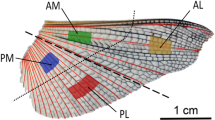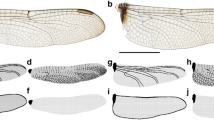Abstract
Two main types of joints occur in the damselfly wing: mobile and immobile. Some longitudinal veins (RP2–, RP3&4–, and MP–) are elastically joined with cross veins, whereas other longitudinal veins (IR1+, IR2+, MA+, CuA'+) are firmly joined with cross veins. In this study we mapped the distribution of serial elastic elements in the wing. The occurrence of resilin, a rubberlike protein, in mobile joints suggests that the automatic twisting mechanism of the leading edge by aerodynamic force works not by flexibility but by the elasticity of these joints. First, it should result in elastic energy storage in the distal areas of the wing. Second, serial elastic elements of wing presumably act as dampers of an aerodynamic force, which are responsible for gradual twisting of the leading edge.
Similar content being viewed by others
Author information
Authors and Affiliations
Additional information
Received: 16 March 1999 / Accepted in revised form: 26 August 1999
Rights and permissions
About this article
Cite this article
Gorb, S. Serial Elastic Elements in the Damselfly Wing: Mobile Vein Joints Contain Resilin. Naturwissenschaften 86, 552–555 (1999). https://doi.org/10.1007/s001140050674
Issue Date:
DOI: https://doi.org/10.1007/s001140050674




